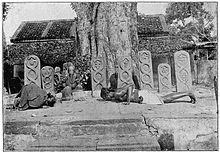Vellalar
| Vellalar | |
|---|---|
| Religions | Hinduism |
| Languages | Tamil |
| Subdivisions |
|
| Related groups | Tamil people |
Vellalar is a generic Tamil term used primarily by various castes who traditionally pursued agriculture as a profession in the Indian states of Tamil Nadu, Kerala and northeastern parts of Sri Lanka. Some of the communities that identify themselves as a Vellalar are the numerically strong Arunattu Vellalar, Chozhia Vellalar, Karkarthar Vellalar, Kongu Vellalar, Thuluva Vellalar and Sri Lankan Vellalar.[2][3] Despite being a relatively lowly group, they were dominant communities in Tamil agrarian societies for 600 years until the decline of the Chola empire in the 13th century, with their chieftains able to practise state-level political authority after winning the support and legitimisation of Brahmins and other higher-ranked communities with grants of land and honours.[4]
Etymology
The word Vellalar may come from the root Vellam for flood, which gave rise to various rights of land; and it is because of the acquisition of land rights that the Vellalar got their name.[5]
The earliest reference to the name is attested in the Tolkāppiyam, which divided the society in four classes Arasar, Andanar, Vanigar and Vellalar.[6]
History

The Vellalars have a long cultural history that goes back to over two millennia in southern India,[7] where once they were the ruling and land-owning community.[8][9]
According to the anthropologist Kathleen Gough, "the Vellalars were the dominant secular aristocratic caste under the Chola kings, providing the courtiers, most of the army officers, the lower ranks of the kingdom's bureaucracy, and the upper layer of the peasantry".[9]
The Vellalars who were land owners and tillers of the soil and held offices pertaining to land, were ranked as Sat-Sudra in the 1901 census; with the Government of Madras recognising that the 4-fold division (four varnas) did not describe the South Indian, or Dravidian, society adequately.[10] Following the arrival of Dutch missionaries in the early 18th century, some Vellalar converted to Christianity.[11]
Sri Lanka
The Vellalars of Sri Lanka have been chronicled in the Yalpana Vaipava Malai and other historical texts of the Jaffna kingdom. They form half of the Sri Lankan Tamil population and are the major husbandmen, involved in tillage and cattle cultivation.[12][2] Local Sri Lankan literature, such as the Kailiyai Malai, an account on Kalinga Magha, narrates the migration of Vellala Nattar chiefs from the Coromandel Coast to Sri Lanka.[13]
Their dominance rose under Dutch rule and they formed one of the colonial political elites of the island.[14][15]
See also
- List of Vellalars
- List of Vellalar sub castes
- Ponnambalam-Coomaraswamy family
Notes
References
- ^ "Vellala | Encyclopedia.com". www.encyclopedia.com.
- ^ a b Derges, Jane (2013). Ritual and Recovery in Post-Conflict Sri Lanka. Routledge. p. 77. ISBN 978-1136214882.
- ^ Ramaswamy, Vijaya (2017). Historical Dictionary of the Tamils. Rowman & Littlefield. p. 390. ISBN 978-1-53810-686-0.
- ^ Moffatt, Michael (2015). An Untouchable Community in South India: Structure and Consensus. Princeton University Press. p. 37. ISBN 978-1-40087-036-3.
- ^ Venkatasubramanian, T. K. (1993). Societas to Civitas: evolution of political society in South India : pre-Pallavan Tamil̤akam. Kalinga Publications. p. 64. ISBN 9788185163420.
- ^ Ramachandran, C. E. (1974). Ahananuru in Its Historical Setting. University of Madras. p. 58.
- ^ Iravatham Mahadevan. "Meluhha and Agastya : Alpha and Omega of the Indus Script" (PDF). p. 16. Archived from the original (PDF) on 7 June 2011. Retrieved 7 June 2011.
The Ventar-Velir-Velalar groups constituted the ruling and land-owning classes in the Tamil country since the beginning of recorded history
- ^ André Wink (2002). Al-Hind: Early medieval India and the expansion of Islam, 7th-11th centuries. Brill Academic Publishers. p. 321. ISBN 9004092498.
Not only were the Vellalas the landowning communities of South India,...
- ^ a b Gough, Kathleen (2008). Rural Society in Southeast India. Cambridge University Press. p. 29. ISBN 9780521040198.
- ^ Pamela G. Price (3 December 2007). Kingship and political practice in colonial India. Cambridge University Press. p. 61. ISBN 9780521052290.
...when government census officers placed Vellalar in the Sat-Sudra or Good Sudra category in its 1901 census, Vellalar castemen petitioned this designation, protesting this designation..
- ^ Etherington, Norman, ed. (2005). Missions and Empire. Oxford University Press. p. 112. ISBN 978-0-19153-106-4.
- ^ Fernando, A. Denis N. (1987). "PENINSULAR JAFFNA FROM ANCIENT TO MEDIEVAL TIMES: Its Significant Historical and Settlement Aspects". Journal of the Royal Asiatic Society of Sri Lanka. 32: 84. JSTOR 23731055.
- ^ Holt, John (2011). The Sri Lanka Reader: History, Culture, Politics. Duke University Press. p. 84. ISBN 978-0822349822.
- ^ Gerharz, Eva (3 April 2014). The Politics of Reconstruction and Development in Sri Lanka: Transnational Commitments to Social Change. Routledge. p. 73. ISBN 9781317692799.
- ^ Welhengama, Gnanapala; Pillay, Nirmala (2014). The Rise of Tamil Separatism in Sri Lanka: From Communalism to Secession. Routledge. p. 168. ISBN 9781135119713.
Further reading
- Lucassen, Jan; Lucassen, Leo (2014). Globalising Migration History: The Eurasian Experience. BRILL. ISBN 978-9-00427-136-4.
- Vellalar
- Social groups of Tamil Nadu
- Indian castes